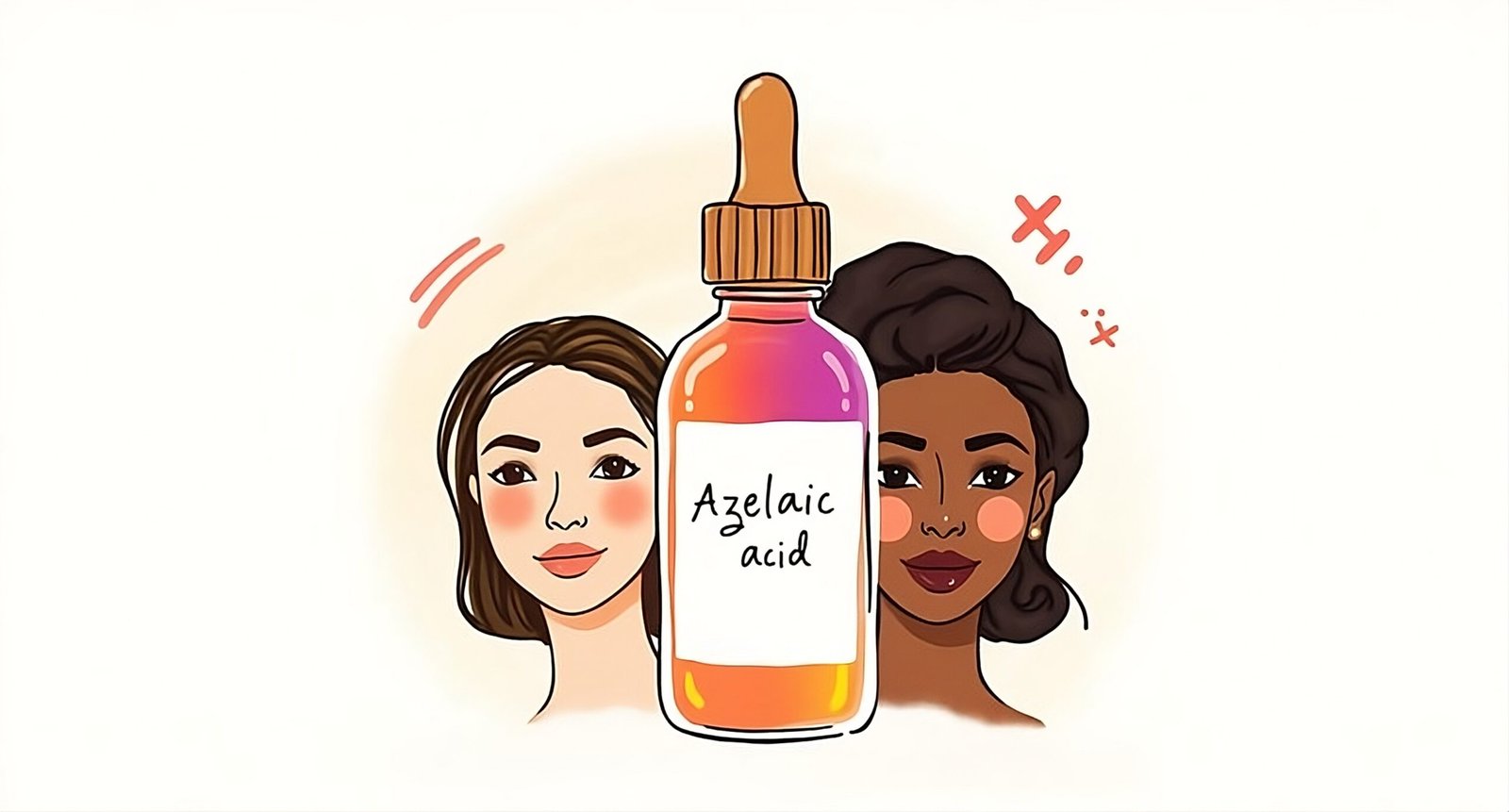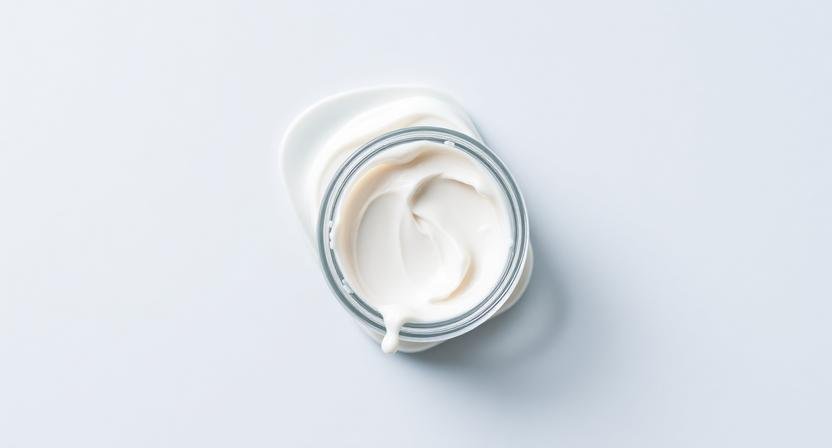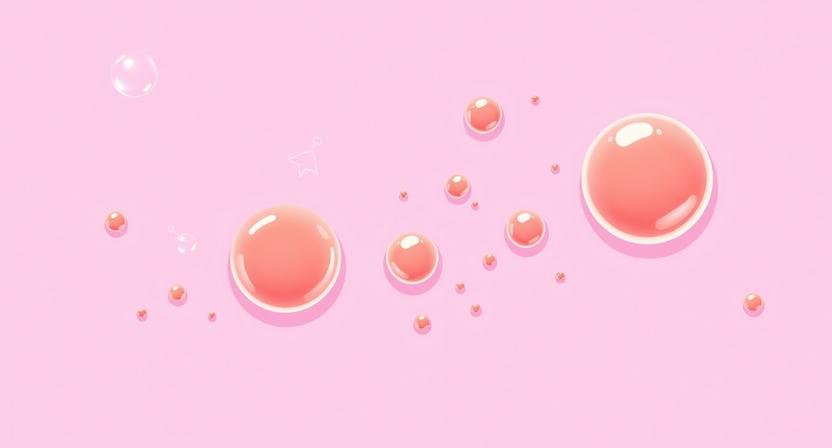Azelaic Acid, Benefits, Side Effects, and Who Should Use It

Azelaic acid has a quiet vibe. It will not tingle like a peel. It will not peel like a retinoid. It works in the background, steady and reliable. If your skin breaks out, gets red for no reason, or holds on to dark marks for months, this ingredient deserves a spot on your shelf. Think of it as a multitasker that smooths, calms, and evens tone without a lot of drama.
Below is a we will explain what azelaic acid is, how it works, who should use it, who should be careful, and how to fit it into a routine without wrecking your barrier. We will keep sentences short, the steps simple, and the advice practical.
What Azelaic Acid Is
Azelaic acid is a dicarboxylic acid found in grains and also made in labs for skincare. Do not let the word acid scare you. It is much gentler than strong exfoliating acids like glycolic. It has three main talents. It helps clear clogged pores, it calms visible redness, and it reduces the look of dark spots. Most people use a ten percent serum or cream from the store. Dermatologists can prescribe fifteen to twenty percent for tougher cases.
How It Works on Skin
Azelaic acid targets several pathways at once. It helps normalize how skin cells shed inside pores, so blockages form less often. It reduces the stress response in red, reactive skin. It lowers the activity of the enzyme that drives excess pigment, which is why dark marks fade faster. It also creates an environment that is less friendly to the bacteria involved in acne. The blend of these actions explains why one product can help both breakouts and redness.
The Big Benefits
Breakouts and clogged pores
Azelaic acid helps pores stay clear. It will not deflate a cyst overnight, yet it reduces the tiny plugs that turn into bumps later. Over several weeks you see fewer fresh whiteheads, fewer small papules, and less rough texture on the cheeks and jaw. If your skin hates harsh spot treatments, this lane feels calmer and more consistent.
Redness and rosacea prone skin
Many people with easy flushing or rosacea struggle with common actives. Azelaic acid is often a better fit. It calms background pink, smooths the look of small bumps that mimic acne, and does not sting once your skin adjusts. If wind and hot rooms light up your face, this is worth a try. Prescription strengths are often used for these cases, but many find relief even at ten percent.
Dark marks and uneven tone
Post blemish marks linger for months on many skin tones. Azelaic acid helps by slowing excess pigment production and by nudging faster turnover. The change is gradual. Expect clearer tone in six to twelve weeks with steady use. It plays well with sunscreen and with gentle brighteners like niacinamide, which makes it easier to build a simple tone routine.
Texture and dullness
You will not see a dramatic peel. You will see a slow change from dull and gritty to smoother and more even. Makeup sits better. Skin reflects light more evenly. If stronger acids make you red, azelaic acid gives you another path to soft texture without the crash.
Who should consider it
You get regular small breakouts. Your face flushes with heat or stress. You see long lasting dark marks after acne. You want one step that hits several targets. You have sensitive or combination skin that hates a loud routine. You tried strong acids and your skin said nope. You want a pregnancy friendly option according to many dermatologists, with the usual advice to check with your clinician first.
Who should be cautious
You have very dry, peeling skin right now. Calm it first, then add azelaic acid later. You have a known allergy to an ingredient in a specific formula. Patch test to be safe. You have a complex medical skin condition that is not yet diagnosed. See a dermatologist before adding several new things at once. Azelaic acid is well tolerated in most cases, but care always starts with a clear plan.
Forms and strengths
Store options usually sit around ten percent. They come as gels, creams, or milky serums. Prescription options are fifteen to twenty percent. They feel richer and you use less. Higher strength is not always better. Many people see great results with ten percent because they actually stick with it. Choose the texture that matches your skin mood. Gel for oily or warm weather. Cream for dry or winter air. Milky serum if you like layers.
How to start without irritation
Go slow. Cleanse with lukewarm water and a gentle face wash. Pat dry. At night, apply a pea sized amount of azelaic acid to the full face or only to problem zones. Follow with a simple moisturizer. Do this every third night for two weeks. If all is calm, move to every other night. If your skin is happy, daily use is fine, yet many people do best with four to five nights per week.
If you are very sensitive, use the sandwich method. Moisturizer, a thin layer of azelaic acid, then another thin layer of moisturizer. This softens the initial feel and keeps your barrier friendly.
Side effects and how to handle them
Most people sail through. Some feel a light tingle in the first few uses. That should fade in minutes. Mild dryness can show up in week one and then settle. If you get steady burning, hives, or a rash that spreads, stop and get advice.
Things that help:
use a gentle cleanser, avoid hot water, apply less product, give it a rest night, and add a barrier focused moisturizer with ceramides and cholesterol. Sunscreen is required, because sun deepens dark marks and slows healing. If you are using a prescription, follow your doctor’s plan before you tweak frequency.
How long until you see change
Comfort can improve in days if redness is the main issue. Texture and small breakouts usually shift in four to eight weeks. Pigment takes longer. Expect real changes in eight to twelve weeks and continued improvement with ongoing use. Keep photos in the same light each week. Progress is easier to see when you stop guessing.
Day or night
Night is the easiest place to start. Fewer layers, less friction, more time to work. If your formula sits well under sunscreen and makeup, morning use can help maintain even tone. If you see pilling with your base, keep azelaic acid for night only and let mornings stay simple. Always apply sunscreen in the day. Azelaic acid does not replace protection.
What pairs well with azelaic acid
Niacinamide, glycerin, panthenol, ceramides, squalane, and mineral rich thermal waters. These support the barrier and amplify the even tone effect. Many people also pair a retinoid at night on alternate days. That duo helps both acne and dark marks while keeping irritation reasonable. If you use vitamin C in the morning, keep textures thin and allow each layer to set. If you use salicylic acid, alternate days rather than stacking each step at once.
What to avoid at the same time
You do not need to stack every active daily. If you also love strong peels, keep those to once a week and skip azelaic acid that night. If your face feels warm or tight, reduce frequency before you add more. Fragrance heavy mists and strong alcohol toners can push irritation during the first weeks. Park them until your skin feels settled.
Routines by skin type
Oily or combination skin
Morning, gentle cleanse, light hydrating serum, non greasy sunscreen. Night, cleanse, azelaic acid as a thin layer, gel cream to seal. Add a retinoid every third night once things are calm. Use a tiny amount of mattifying primer only in the center if you wear makeup.
Dry or tight skin
Morning, creamy cleanser or just a rinse, hydrating serum, mid weight moisturizer, sunscreen. Night, cleanse, moisturizer, azelaic acid, another whisper of moisturizer. Keep layers thin, but do not skip the cushion. Consider a humidifier in winter.
Sensitive or reactive skin
Morning, rinse, barrier moisturizer, sunscreen. Night, cleanse, moisturizer only for one week. In week two, patch test azelaic acid on the jaw for two nights. If quiet, use every third night with a moisturizer sandwich. Skip extra peels for now.
Acne prone with dark marks
Morning, gentle cleanse, niacinamide, sunscreen. Night, cleanse, azelaic acid, retinoid on alternate nights, light moisturizer. Keep benzoyl peroxide for spots only. Do not layer it on top of azelaic acid on the same night at first. Once your skin is calm, you can test a thin layer of benzoyl peroxide on breakout zones with azelaic acid on the rest of the face.
Azelaic acid and deeper skin tones
Darker skin types often deal with lingering marks after even small pimples. Azelaic acid shines here because it targets pigment pathways in a gentle way. It helps fade marks while causing less dryness than many brighteners. It also works without the chalky cast some strong actives leave behind. Pair it with diligent sunscreen. Protection is what keeps new pigment from forming while the old fades.

Pregnancy and breastfeeding
Many dermatologists consider azelaic acid an option in pregnancy and while breastfeeding. People still vary, and medical history matters. The safest move is to confirm with your clinician before you start. If it is green lit, stick to simple routines and move slow.
Patch testing made easy
Apply a small amount to the jawline for two nights. If you see burning, rash, or swelling, stop. If nothing happens, try one cheek for a night. Then try the full face. Keep notes on your phone. Track dates and how your skin felt. This tiny habit prevents confusion later.
Sunscreen is not optional
Redness, acne marks, and melasma all worsen with sun. Azelaic acid helps, yet it cannot fight the sun alone. Wear a broad spectrum sunscreen daily. Use a fluid or gel if you dislike heavy creams. Give it a minute to set before makeup. If you will be outside long, reapply with a powder sunscreen or a mist formulated for reapplication over makeup.
Common myths
Azelaic acid is only for rosacea. Not true. It helps acne, pigment, and texture too.
It is too weak to make a difference. Also not true. Results are slower, but they are steady and often easier to maintain than harsh peels.
You cannot combine it with anything. You can. Just alternate powerful partners and add one new step at a time.
It will bleach skin. No. It balances excess pigment production rather than bleaching the skin. Even tone, not lighter tone, is the goal.
Troubleshooting
Your face feels tight after week one. Add more moisturizer, reduce frequency, avoid hot water, and keep the cleanser gentle.
You see tiny bumps you did not have. That can be adjustment or a product clash. Pause other new items, use azelaic acid every third night, and simplify. If bumps persist after three to four weeks, stop and reassess.
Your makeup pills. Use a smaller amount of product, wait a full minute between layers, match textures in your base. Water based with water based, silicone with silicone. Move azelaic acid to night if needed.

A sample plan
Week one – use azelaic acid every third night with a light moisturizer.
Week two – move to every other night if all is calm.
Week three – introduce a retinoid on the nights you do not use azelaic acid, or keep azelaic acid daily if you prefer a single active.
Week four – keep going. Add niacinamide in the morning if you want more even tone. Protect with sunscreen every day.
When to see a dermatologist
If you have painful cysts, persistent redness with eye symptoms, or pigment that does not shift after three months, book a visit. You may benefit from prescription strengths or from pairing azelaic acid with other medical treatments. A pro can also rule out conditions that mimic acne or rosacea.
The bottom line
Azelaic acid is the quiet professional in skincare. It clears small clogs, calms visible redness, and fades lingering marks. It fits sensitive routines and complexions that distrust loud actives. It pairs well with moisturizers and sunscreen. It works best with time and consistency, not with force. If you want one bottle that supports clearer, calmer, more even skin, this is it. Start small. Keep it regular. Let your barrier stay happy. Then watch your skin become easier to live with day after day.